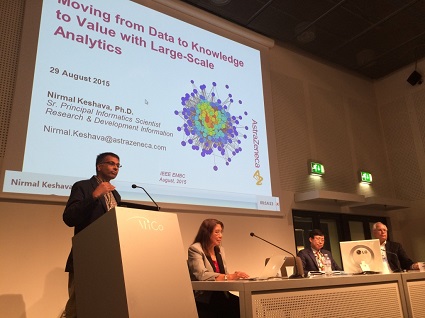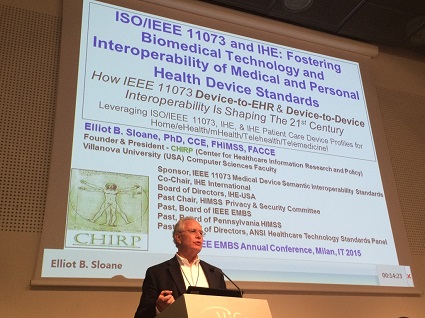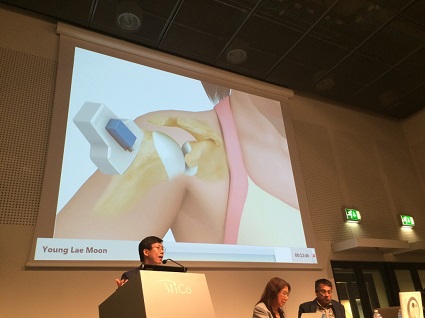The Pharmaceutical Industry, Emerging Technology, and Standards
by Nirmal Keshava
IEEE Life Sciences Technical Committee members spoke at EMBC15 about emerging technologies and the move toward open standards, which among many other potential benefits also offers opportunities to address challenges in drug development.
The IEEE Life Sciences Technical Committee on Standards held a special session at the recent IEEE EMBC Annual Conference in Milan on Saturday, 29 August 2015. The session was co-chaired by Carole Carey and Bruce Hecht. The session touched on current efforts in standards development for key life science technologies that are critical to all members of the life science community, including the pharmaceutical industry, where the challenge is to develop drugs more efficiently and inexpensively.
Drug development is a long and costly undertaking. Recent reports estimate that the average time required to bring a single drug to the market is twelve years at a cost of US$1.2 billion. Combined with the pressure to re-coup costs within the seventeen-year period of patent exclusivity, the pharmaceutical industry has reacted by introducing technology at virtually every stage to increase the efficiency and productivity of the overall drug development process. Starting with the identification of new molecular targets, continuing with the narrowing of candidate chemical compounds, in vitro and animal testing, and concluding with large-scale human trials, drug development is continually looking for new ways to decrease the cost and time required to develop safer and more effective drugs.
Moreover, the rapid explosion of data at every stage has created the need to identify best practices for the storage, transmission, protection, and analysis of data. Led by the arrival of genomic technology platforms, the IT infrastructure that enables drug development is a critical and fast-changing space.
The pharmaceutical industry has worked collaboratively in pre-competitive industry forums to jointly develop new capabilities, and it is rapidly adopting technologies where IEEE has a history of expertise and leadership. These include automated screening, imaging, genomics, and wearable and wireless technology. In addition, the development of open standards based upon input from a broad cross-section of industry can result in platforms that meet the stringent regulatory requirements required for government approval while also ensuring that the communities that use them have considered all relevant factors.

Figure 1. Nirmal Keshava speaking at EMBC15.
Nirmal Keshava, from the pharmaceutical company AstraZeneca, was the first speaker in the special session, and he discussed how Big Data is reshaping drug discovery (Figure 1). Keshava pointed out that among many areas, “the ability to mine and model electronic medical records with new algorithms can increase our understanding of how drugs will work in specific populations. Standards can play a big role moving the industry forward.” Carole Carey, the LSTC Standards Committee Chair, followed by describing how consensus-driven standards can, among other things, uncover liabilities and thereby ensure the safety of new technologies (Figure 2).

Figure 2. Carole Carey, LSTC Standards Committee Chair.

Figure 3. Elliot Sloane, Center for Healthcare Information Research and Policy.
Elliot Sloane, from the Center for Healthcare Information Research and Policy, discussed how IEEE standard 11073 is enabling interoperability of computer-enabled technology across medicine (Figure 3). As large numbers of hospitals are launching medical device integration projects, “growing numbers of countries are adopting IEEE 11073 compatible personal health devices for telehealth.” Finally, Young Moon, MD, from Chosun University Hospital in South Korea illustrated how advanced imaging and visualization technologies are changing orthopedic surgery (Figure 4). He also reflected on his efforts to develop standards for 3-D medical visualization, and the projected impact they will have on surgical planning. Further, he pointed out that emerging medical wearable devices, such as the ones that are worn by surgeons, are increasingly built from combinations of different technologies, each enabled by standards.

Figure 4. Young Moon, MD, Chosun University Hospital, South Korea.
The formal presentations were followed by an interactive session that included questions from members of the audience. Some of the main conclusions that emerged were the need to educate key stakeholders about the importance of standards, and the value of capitalizing on existing standards, particularly in the academic community.
Collectively, the presentations and discussions touched on different technological challenges that are relevant to drug development. For example, Phase 3 clinical trials frequently cost hundreds of millions of dollars and involve many critical stages of decision-making. Many trials are augmenting their traditional measurements with wearable technology, especially for diseases where recovery or improvement in quality of life is difficult to quantify. Additionally, as the criteria for inclusion in clinical trials targets more specific patient populations, electronic medical records are being analyzed to prospectively assess the feasibility of finding patients, as well as geographically locate enriched populations of candidate patients. All of these efforts have the potential of reducing the risk and cost of clinical trials.
The special session demonstrated that emerging technologies are poised to change health care and drug development. A critical component of enabling standards is a continued dialogue between these communities and the engineering community that will enable a better understanding of the value that standards can bring to developing new drugs. While the pharmaceutical industry has not traditionally intersected with the engineering community, IEEE can play an important role developing standards for technologies in an open, consensus-driven environment that will help produce drugs more rapidly and efficiently, and that are safer and more effective.
Contributor
 Nirmal Keshava is a Senior Principal Informatics Scientist at AstraZeneca, PLC in Waltham, MA, where he is leading efforts to use large-scale analytics to improve the cost and efficiency of drug development. He received his doctorate in electrical and computer engineering from Carnegie Mellon University and his undergraduate degree from UCLA and has worked at Bell Communications Research, MIT Lincoln Laboratory, and Draper Laboratory. Read more
Nirmal Keshava is a Senior Principal Informatics Scientist at AstraZeneca, PLC in Waltham, MA, where he is leading efforts to use large-scale analytics to improve the cost and efficiency of drug development. He received his doctorate in electrical and computer engineering from Carnegie Mellon University and his undergraduate degree from UCLA and has worked at Bell Communications Research, MIT Lincoln Laboratory, and Draper Laboratory. Read more







 Bill Ash is Strategic Program Manager for the IEEE Standards Association (IEEE-SA). He received his BSEE from Rutgers University School of the Engineering. His background is in the RF industry as he worked as applications engineer on wireless communications systems.
Bill Ash is Strategic Program Manager for the IEEE Standards Association (IEEE-SA). He received his BSEE from Rutgers University School of the Engineering. His background is in the RF industry as he worked as applications engineer on wireless communications systems.